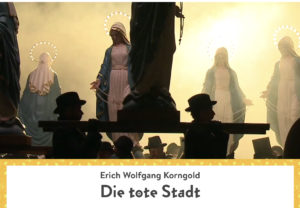THE STORY:
Die tote Stadt (German for The Dead City), Op. 12, is an opera in three acts by Erich Wolfgang Korngoldset to a libretto by Paul Schott, a collective pseudonym for the composer and his father, Julius Korngold. It is based on the 1892 novel Bruges-la-Morte by Georges Rodenbach.Rodenbach’s novel Bruges la Morte had already been adapted by the author into a play. The play was translated into German by Siegfried Trebitsch under the title Die stille Stadt (The Silent City), which he later changed to Das Trugbild (The Mirage). Trebitsch was a friend of Korngold’s father, Julius. The two met in the street one day and got into a conversation about a possible operatic adaptation. Trebitsch later met Erich, who was enthusiastic about the project. Trebitsch recalled “[I] met the young master Erich Wolfgang Korngold in search of a scenario or, even better, a mood or operatic background that could be dramatically elaborated. I urged him to take up Das Trugbild.”[1] Julius commented on the way the project evolved:As soon as Erich read the play, he drafted a scenario for a one-acter, but Hans Müller urged him to get away from one-act operas and he sketched the first of three acts in prose. However, his work on two of his own plays prevented him from getting much further, and since his prose was wordy and unsingable anyway, we gladly excused him from the task.Father and son decided to adapt the play themselves, and co-wrote the libretto, using the pseudonym Paul Schott. Julius decided to change the plot so that the murder occurs in a dream, rather than in actuality, as in the original. Korngold started the composition in 1916. He left it for a year to take up military service before resuming and completing the score.(Wikipedia.org)
